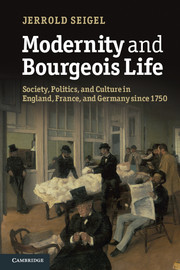 Modernity and Bourgeois Life
Modernity and Bourgeois Life Book contents
- Frontmatter
- Contents
- Illustrations
- Preface
- 1 Introduction: ends and means
- Part I Contours of modernity
- 3 Monarchical centralization, privilege, and conflict: France
- 4 Localism, state-building, and bürgerliche Gesellschaft: Germany
- 5 Modern industry, class, and party politics in nineteenth-century England
- 6 France and bourgeois France: from teleocracy to autonomy
- 7 One special path: modern industry, politics, and bourgeois life in Germany
- Part II Calculations and lifeworlds
- 9 Men and women
- 10 Bourgeois morals: from Victorianism to modern sexuality
- 11 Jews as bourgeois and network people
- Part III A culture of means
- 13 Bourgeois and others
- 14 Bourgeois life and the avant-garde
- 15 Conclusion
- Notes
- Index
Preface
Published online by Cambridge University Press: 05 June 2012
- Frontmatter
- Contents
- Illustrations
- Preface
- 1 Introduction: ends and means
- Part I Contours of modernity
- 3 Monarchical centralization, privilege, and conflict: France
- 4 Localism, state-building, and bürgerliche Gesellschaft: Germany
- 5 Modern industry, class, and party politics in nineteenth-century England
- 6 France and bourgeois France: from teleocracy to autonomy
- 7 One special path: modern industry, politics, and bourgeois life in Germany
- Part II Calculations and lifeworlds
- 9 Men and women
- 10 Bourgeois morals: from Victorianism to modern sexuality
- 11 Jews as bourgeois and network people
- Part III A culture of means
- 13 Bourgeois and others
- 14 Bourgeois life and the avant-garde
- 15 Conclusion
- Notes
- Index
Summary
Preface
In my second semester of graduate school, the professor who soon became my main advisor – a deeply serious man with a broad streak of playful irony – assigned me the boggling task of regaling the following week’s seminar with ten minutes of reflection on the question: “What is the bourgeoisie?” How I sought to meet his challenge is not worth recalling, but in many ways I have been trying to face up to it ever since. Among the disparate subjects I have attempted to teach and write about over the years, a number turn out to have been linked together by a not-always-evident effort to chisel out bits and pieces of an answer: Karl Marx, French bohemianism, the history of modern thinking about the self, even the career of Marcel Duchamp. Except that I have come to think that we do better to recast the question, replacing its traditional nominative formulation with ones that are more adjectival and historical: why does the modifier “bourgeois” bear a range of meanings that often apply to people, things, actions, and ideas outside the social group it is supposed to designate? What does this array of meanings tell us about the link often posited between bourgeois life and modernity? How does this relationship between the things we call bourgeois and those we call modern alter as both of its components change over time? These questions are not always explicitly addressed in Modernity and Bourgeois Life – the Introduction sets out the ones that are – but they outline the historical and analytical space the book attempts to explore.
- Type
- Chapter
- Information
- Modernity and Bourgeois LifeSociety, Politics, and Culture in England, France and Germany since 1750, pp. ix - xiiPublisher: Cambridge University PressPrint publication year: 2012
